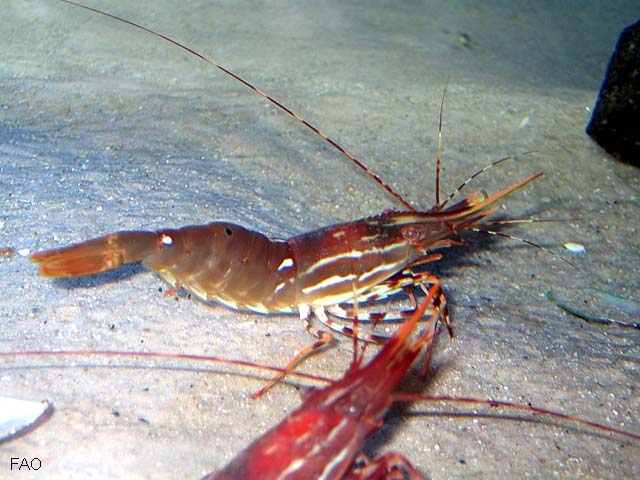| Pandalidae (pandalid shrimps) |
| 30 cm TL (male/unsexed); max.weight: 120.0 g; max. reported age: 6 years |
|
benthic; marine; depth range 0 - 2648 m |
| Eastern Pacific: The west coast of north America from Unalaska Island to Kachemak Bay and Prince William Sound south to Punta Eugenia, Baja California Sur, Mexico. |
|
"Prawn" of British Columbia, sometimes called the giant shrimp. The body is stout; the carapace covered with a dense short pubescence. The colour of the adults is fawn to red with several distinct white stripes and spots, but the younger individuals show a variety of coloration. Some are green, others brown, while yet others show the red of red algae and
hydroids. This colour change seems to correspond to a change in habitat, for the young specimens live in comparatively shallow water amongst seaweeds and hydroids, while the older individuals go down into deep water. The rostrum is one and a half to one and two thirds times as long as the carapace. There are 14 to 17 dorsal spines extending to the middle of the rostrum, and usually a solitary spine not far behind the acute tip, while the lower limb is armed with 7 or 8 fixed spines. |
| Maximum depth from Ref. 104449. Maximum common depth from Ref. 104007. Epibenthic (Ref. 91773). Found in bed rocks to muddy sand substrates with adequate shelter for day light hiding (Ref. 91741). Also in crevices on rock faces and in lairs under boulders (Ref. 91824). Nocturnal. Carnivorous and feeds by scavenging on dead animal materials and preying on amphipods, euphausiids, limpets, annelids and other shrimps (Ref. 91741). Preyed upon by fish and octopuses. Also probably eaten by fish such as lingcod, dogfish, and Pacific cod (Ref. 91824). Associated with drift algae, specifically loose kelp (Ref. 91824). Predominantly uses Agarum fimbriatum and Agarum cribrosum kelp beds as nursery habitats (Ref. 91825). |
|
Not Evaluated (N.E.) Ref. 123251)
|
|
|
Source and more info: www.sealifebase.org. For personal, classroom, and other internal use only. Not for publication.

